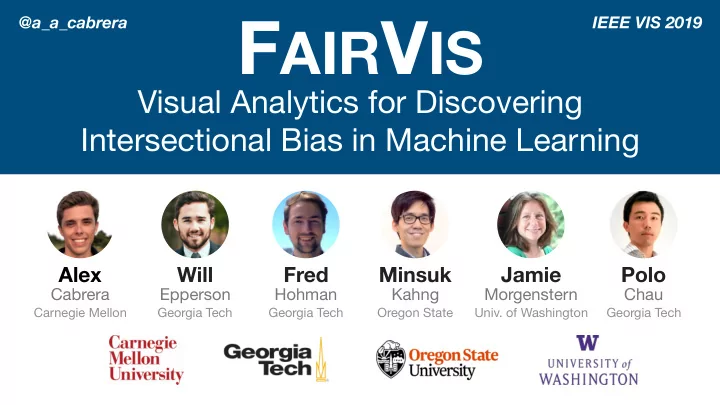

F AIR V IS @a_a_cabrera IEEE VIS 2019 Visual Analytics for Discovering Intersectional Bias in Machine Learning Alex Will Fred Minsuk Jamie Polo Cabrera Epperson Hohman Kahng Morgenstern Chau Carnegie Mellon Georgia Tech Georgia Tech Oregon State Univ. of Washington Georgia Tech
Recidivism Prediction Self-Driving Cars Machine learning is being deployed to various societally impactful domains Angwin J, Larson J, Mattu S, Kirchner L. 2016. Machine bias: There’s Wilson, B., Ho ff man, J., & Morgenstern, J. (2019). Predictive software used across the country to predict future criminals and it’s inequity in object detection. arXiv preprint arXiv:1902.11097 . biased against blacks. www.propublica.org 2 https://www.youtube.com/watch?v=YN_KUw81130 https://www.wired.com/story/crime-predicting-algorithms-may-not-outperform-untrained-humans/
Recidivism Prediction Self-Driving Cars Unfortunately, these systems can perpetuate and worsen societal biases Angwin J, Larson J, Mattu S, Kirchner L. 2016. Machine bias: There’s Wilson, B., Ho ff man, J., & Morgenstern, J. (2019). Predictive software used across the country to predict future criminals and it’s inequity in object detection. arXiv preprint arXiv:1902.11097 . biased against blacks. www.propublica.org 3 https://www.youtube.com/watch?v=YN_KUw81130 https://www.wired.com/story/crime-predicting-algorithms-may-not-outperform-untrained-humans/
4
Fairness is a wicked problem Issues so complex and dependent on so many factors that it is hard to grasp what \ exactly the problem is, or how to tackle it. 5 http://theconversation.com/wicked-problems-and-how-to-solve-them-100047
FairVis Visual analytics for discovering biases in machine learning models 6
Challenges for Discovering Bias 7
1 Intersectional bias 8
Disparities in Gender Classification Buolamwini, J., & Gebru, T. (2018, January). Gender shades: Intersectional accuracy disparities in commercial gender classification. In Conference on fairness, accountability and transparency (pp. 77-91). 9
10
11
2 Defining Fairness 12
Fairness Accuracy? Recall? Definitions False Positive Rate? F1 Score? Predictive Power? Over 20 di ff erent measures of fairness are found in the ML fairness literature Verma, Sahil, and Julia Rubin. "Fairness definitions explained." 2018 IEEE/ACM International Workshop on Software Fairness (FairWare). IEEE, 2018. 13
Impossibility of Fairness Calibration Some measures of fairness are mutually exclusive, have to Negative Positive Pick 2 Class Class pick between them Balance Balance Kleinberg, Jon, Sendhil Mullainathan, and Manish Raghavan. "Inherent Trade-O ff s in the Fair Determination of Risk Scores." 8th Innovations in Theoretical Computer Science Conference (ITCS 2017). Schloss Dagstuhl-Leibniz-Zentrum fuer Informatik, 2017. 14
Challenges 1 Auditing the performance of hundreds or thousands of intersectional subgroups 2 Balancing dozens of incompatible definitions of fairness 15
Race Accuracy African-American 73 Asian 77 Caucasian 79 Hispanic 91 88 Native American 67 Other 16
Race, Sex Accuracy African-American, Male 60 Asian, Male 86 Caucasian, Male 96 Hispanic, Male 91 Native American, Male 75 Other, Male 81 African-American, Female 97 Asian, Female 66 Caucasian, Female 73 Hispanic, Female 91 Native American, Female 92 Other, Female 84 17
Race, Sex Accuracy FPR FNR F1 Precision … African-American, Male 87 74 61 68 95 86 Asian, Male 83 93 77 74 88 84 Caucasian, Male 80 82 93 71 72 88 Hispanic, Male 96 86 85 92 81 63 Native American, Male 89 85 76 85 93 97 Other, Male 78 69 90 76 68 62 African-American, Female 72 72 99 67 75 61 Asian, Female 84 68 65 91 71 71 Caucasian, Female 88 100 91 63 87 95 Hispanic, Female 76 94 99 71 77 64 Native American, Female 82 65 65 98 81 78 Other, Female 86 98 72 83 72 69 18
FairVis Auditing the COMPAS Model Risk scoring for recidivism prediction
Use Case 1 Auditing for Suspected Bias 21
Visualize specific subgroups Performance of the African-American Male subgroup 22
avg: 65.86% Accuracy avg: 65.05% Precision avg: 60.77% Recall 23
avg: 65.86% Accuracy avg: 65.05% Precision avg: 60.77% Recall = Subgroup of African-American Males 24
Visualize all the combinations of subgroups for selected features African-American Male, Caucasian Male, African-American Female, etc. 25
Filter for significantly large subgroups 26
Select preferred metrics, in this case the false positive rate 27
Compare the subgroups with the highest and lowest false positive rate 28
Use Case 2 Discovering Unknown Biases 29
A Suggested Subgroups 30
70% Accuracy Shape Classification 31
Cluster 1 Cluster 2 88% 50% Cluster 4 Cluster 3 83% 50% 32
B Similar Subgroups 34
.5 .75 .5 35
Compare the African-American Male subgroup to a similar subgroup of Other Male 36
Intersectional Multiple Definitions Bias of Fairness By tackling F1 ACC TPR FPR FairVis Enables users to find biases in their models Audit for Explore Suggested & Known Biases Similar Subgroups Allowing users to 37
F AIR V IS Learn more at bit.ly/fairvis Visual Analytics for Discovering Alex Cabrera Intersectional Bias in Machine Learning Carnegie Mellon Will Epperson Georgia Tech Fred Hohman Georgia Tech Minsuk Kahng Oregon State Jamie Morgenstern University of Washington Polo Chau Georgia Tech 38
Recommend
More recommend